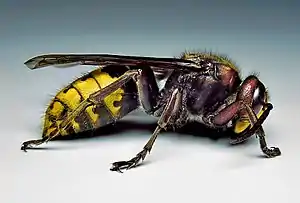| Vespinae Temporal range: | |
|---|---|
 | |
| European hornet, Vespa crabro | |
| Scientific classification | |
| Domain: | Eukaryota |
| Kingdom: | Animalia |
| Phylum: | Arthropoda |
| Class: | Insecta |
| Order: | Hymenoptera |
| Family: | Vespidae |
| Subfamily: | Vespinae Latreille, 1802 |
| Genera | |
The subfamily Vespinae contains the largest and best-known groups of eusocial wasps, including true hornets (the genus Vespa), and the "yellowjackets" (genera Dolichovespula and Vespula).[1] The remaining genus, Provespa, is a small, poorly known group of nocturnal wasps from Southeast Asia. One genus, Palaeovespa, has been described the Paleocene to Eocene fossil records of North America and Europe.[2] Collectively, the group can be found on all continents except Antarctica, and several of these wasps are invasive species, introduced beyond their native ranges, and can be major pests.

Palaeovespa florissantia, an extinct wasp
References
Wikispecies has information related to Vespinae.
Wikimedia Commons has media related to Vespinae.
- ↑ Jm, Carpenter (1997). "Checklist of the species in the subfamily Vespinae (Insecta : Hymenoptera : Vespidae)". Nat Hist Bull Ibaraki Univ. 1: 51–92.
- ↑ Yamane, Seiki; Yamane, Sôichi (2021). Starr, Christopher K. (ed.). "Vespinae". Encyclopedia of Social Insects. Cham: Springer International Publishing: 1000–1008. doi:10.1007/978-3-030-28102-1_133. ISBN 978-3-030-28101-4. Retrieved 2023-06-12.
This article is issued from Wikipedia. The text is licensed under Creative Commons - Attribution - Sharealike. Additional terms may apply for the media files.